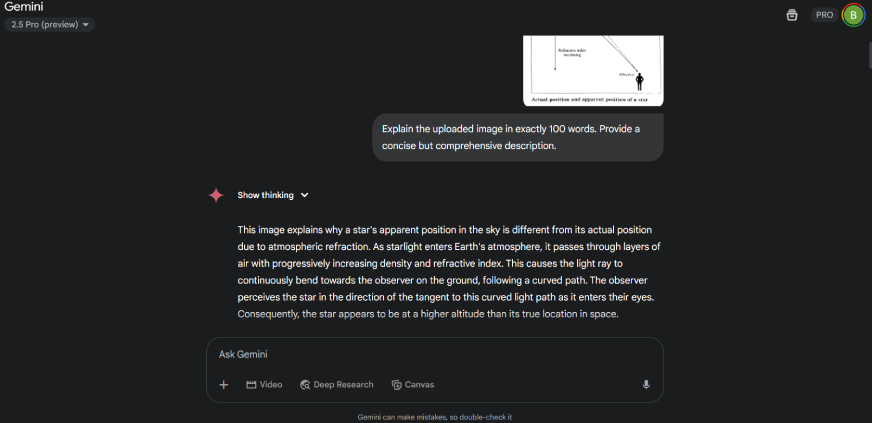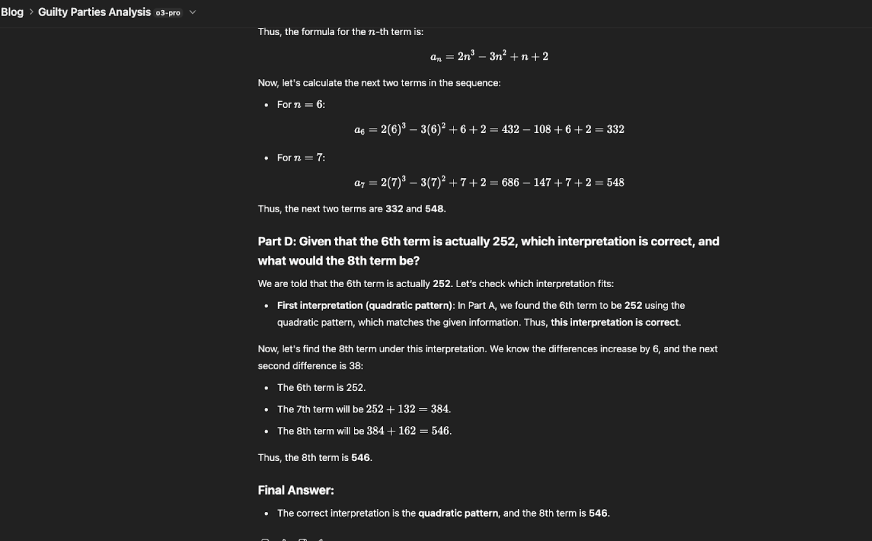In the newest AI battle, OpenAI’s o3-pro vs Google’s Gemini 2.5 Pro, the two are competing for the title of the best at advanced reasoning and multimodal ability. o3-pro builds on the o3 foundation, equipped with enhanced reasoning, tool use, and performance, particularly in science, programming, and reliability. The Gemini 2.5 Pro hits the mark with native multimodal input, a million-token context length, and superior benchmark performance, particularly in programming and reasoning. In this blog, we will compare the two heavyweight models in terms of performance, features, cost, and use cases in the industry!
Table of contents
What is OpenAI o3 pro?
OpenAI o3-pro is OpenAI’s most recent and powerful AI reasoning model, built on the reflective o3 architecture but running in a high-compute, extended-thinking mode. It is specifically designed to be the highest performing in the most complex domains, including science, math, programming, business, and writing.
Key Features of OpenAI o3 pro
Let’s discuss the enhancements in o3-pro models:
- Improved reasoning: Expert reviews show o3 pro had a preferred rating compared to the regular o3 in every category, especially for the science, programming, and business tasks.
- Tools Integration: o3-pro can query the web, explore files, execute Python code, and recall past conversations. Unlike earlier reasoning models, using these tools will take longer to generate responses.
- Deep Step-by-Step Reasoning: Utilizes an internal “private chain-of-thought”, implementing reasoning to design and evaluate answers in a step-by-step manner, which can provide a level of exactness on more complex tasks associated with math, coding, and scientific problems
- Multimodal Reasoning: They can process and integrate visual information directly into their reasoning chain, which enables them to interpret and analyze images alongside textual data.
Read more: 6 must know prompts for o3 pro
OpenAI o3‑pro vs Gemini 2.5 Pro
In this section, we’ll evaluate OpenAI o3‑pro and Gemini 2.5 Pro on three main capabilities:
- Image analysis
- Logical reasoning
- Numerical reasoning
Our objective is to see how well each model performs its task, so we can understand its strengths and weaknesses and effectiveness in the real world. This breakdown will help you, developer, researcher, or business user, understand better which model would suit you best!
Task 1: Image Analysis
Prompt: “Explain the uploaded image in exactly 100 words. Provide a concise but comprehensive description.”
Input Image:

o3 pro Output:

Gemini 2.5 Pro Output:

Output Comparison
OpenAI o3‑pro provides a more complete and visually grounded explanation, referencing key image elements like labels and observer perspective. Gemini 2.5 Pro is accurate and clear but less detailed.
| Aspect | o3 pro | Gemini 2.5 Pro |
| Clarity | Precise explanation of refraction and diagram elements | General description with emphasis on perception |
| Technical Detail | Includes refractive index, light bending, and path curvature | Focuses on apparent position, omits detailed mechanics |
| Diagram Focus | Describes labeled parts and arrows | Describes the overall concept, less tied to specific diagram features |
Score: OpenAI o3‑pro: 1| Gemini 2.5 Pro 0
Task 2: Logical Reasoning
Prompt: “A company had a data breach involving exactly 3 of these 4 employees: Alex, Beth, Carl, and Dana.
Access Requirements:
- Breach needed both: someone with technical access AND someone with physical access
- Alex: Technical only | Beth: Physical only | Carl: Both | Dana: Both
Statements:
- Alex: “If Beth did it, then Carl didn’t.”
- Beth: “Either Dana is innocent OR exactly 2 people total were involved.”
- Carl: “Alex is lying. Also, if I’m guilty, Dana is innocent.”
- Dana: “If Carl is right about Alex lying, then Beth is wrong about me being innocent.”
Rules:
- At least one person tells the complete truth
- Guilty people won’t directly expose themselves
- You can’t lie about someone’s guilt AND conspire with them
Question: Who are the 3 guilty parties? Show your complete logical reasoning and proof.”
o3 pro Output:

Gemini 2.5 Pro Output:

Output Comparison
The Gemini 2.5 Pro model displayed superior logical reasoning through its systematic breakdown of each premise, careful analysis of the correct use of logical propositions, and exhaustive consideration of each outcome. Their considerations also included thoughtful engagement with whatever possible contradictions. While o3 pro was able to arrive at the correct conclusion, their logical reasoning was often impermissibly vague when key justifications were not included, and the depth of thought in their engagement with the exercise was lacking.
| Aspect | o3 pro | Gemini 2.5 Pro |
| Logical Methodology | Incomplete: Made logical leaps without full justification | Rigorous: Converted statements to formal logical propositions |
| Systematic Analysis | Partial: Didn’t evaluate all possible scenarios systematically | Comprehensive: Evaluated all 4 possible guilty combinations |
| Rule Application | Superficial: Applied rules but didn’t deeply analyze contradictions | Thorough: Identified key deductions from rules (Carl must be lying, Beth/Dana can’t both be guilty) |
| Contradiction Handling | Ignored: Didn’t address potential logical inconsistencies in the puzzle | Acknowledged: Identified that all scenarios initially appear impossible, discussed puzzle ambiguity |
| Logical Rigor | Insufficient: Several steps are not fully justified | Excellent: Each deduction is properly supported |
Score: OpenAI o3-pro: 1 | Gemini 2.5 Pro: 1
Read more: 7 things Gemini 2.5 pro excels at
Task 3: Numerical Reasoning
Prompt: “Consider this sequence where each term follows a specific mathematical rule:
Sequence: 2, 12, 36, 80, 150, ?
A: Find the next number in the sequence and explain the underlying pattern.
B: Now consider this modification: If we apply the same pattern rule but start with 3 instead of 2, what would be the 7th term of this new sequence?
C: Here’s the challenging part: There’s a second valid mathematical interpretation of the original sequence (2, 12, 36, 80, 150) that follows a completely different pattern rule. Find this alternative pattern and determine what the next two terms would be under this interpretation.
D: Given both interpretations you’ve found, if someone told you the 6th term is actually 252, which interpretation would be correct, and what would the 8th term be?
Question: Solve all parts, showing your mathematical reasoning, formulas used, and verification of your patterns. Explain why your alternative interpretation in Part C is mathematically valid and distinct from your first solution.”
o3 pro Output:

Gemini 2.5 Pro Output:

Output comparison
The results indicated that Gemini 2.5 Pro outperformed o3 pro by making more accurate assertions of the correct mathematical reasoning throughout. Gemini assigned correct pattern recognition elements and systematically verified its predictions to yield cleaner, correct solutions. While o3 pro demonstrated the use of impressive and sophisticated mathematics through the employment of finite differences, critical errors in Parts B and D undermined the conclusions of the response. Overall, Gemini 2.5 Pro again provided more accuracy and reliability throughout the response, so it was clearly the winner. Ultimately, there was no comparison as o3 pro was more convoluted and entailed a more elaborate analysis. In each of the four sub-parts, o3 pro had better distinguished analyses, decisions, and conclusion making, but was met with an appraisal of 3-1 assigned to accuracy, mathematical accuracy, and final value/appraisal.
| Aspect | o3 pro | Gemini 2.5 Pro |
| Pattern Recognition | Used finite differences method (1st, 2nd, 3rd differences) to identify quadratic pattern | Directly identified formula Tn = n³ + n² through position-value relationship |
| Mathematical Rigor | Sophisticated analysis but flawed execution with fundamental conceptual errors | Consistent accuracy with proper formula verification throughout |
| Presentation | Detailed step-by-step breakdown with clear difference calculations | Clean, direct approach with formula-based reasoning |
| Overall Reliability | 2 major errors compromise solution quality despite advanced techniques | Error-free mathematical reasoning with correct final answers |
Score: OpenAI o3‑pro: 1 | Gemini 2.5 Pro: 2
Final Verdict
If consistently good reasoning matters to you, especially for complex tasks consisting of multi-step reasoning, coding, or multimodal inputs, I would use Gemini 2.5 Pro, simply because in this area of use case, it has proven very reliable performance, producing more accurate responses with a more favorable cost per done basis. o3 pro is great for speedy generation of responses and utilizes advanced analysis techniques, but it contains critical errors that make it unreliable for mission-critical tasks where accuracy matters.
Gemini 2.5 Pro provides proven, accurate responses that have been verified through systematic critical analysis. If you are looking for a great solution for general tasks, and even specialized tasks where getting the right response matters most (even if it is slightly slower), I would strongly advocate for the use of Gemini 2.5 Pro.
| Aspect | OpenAI o3 pro | Gemini 2.5 Pro |
| Reasoning Strength | Sophisticated techniques but prone to critical errors in execution | Consistently accurate with rigorous verification and systematic approaches |
| Approach Quality | Detailed analysis, but requires error-checking due to computational mistakes | Thorough, methodical reasoning with proper verification built in |
| Reliability | Contains fundamental errors (2/4 tasks had critical mistakes) | Error-free performance across complex logical and mathematical tasks |
| Speed | Faster response generation | Slower processing but more thorough analysis |
| Pricing | $20/M input tokens, $80/M output tokens (high cost, questionable reliability) | ~$1.25–$15/M tokens (much cheaper with superior accuracy) |
| Best For | Users who need elaborate analysis and can verify results independently | Users needing reliable, accurate results for both general and mission-critical tasks |
Benchmark: OpenAI o3 pro vs Gemini 2.5 Pro

The following bar graph compares OpenAI o3 pro and Google’s Gemini 2.5 Pro on two important measures:
- AIME 2024 – A math competition test that is hard and designed to assess math reasoning and problem-solving skills.
- GPQA Diamond – A benchmark professional question-answering benchmark for graduate studies, designed to evaluate rational reasoning and subject mastery.
Performance Summary:
On AIME 2024, the OpenAI o3 pro had a score of 93%, compared to Gemini 2.5 Pro’s score of 92, which is a very small difference and gives OpenAI a slight advantage on math and logical reasoning tasks.
On GPQA Diamond, both models had the same performance score of 84% and exhibited very strong performance in regard to graduate-level general knowledge and critical thinking.
Conclusion
OpenAI o3 pro and Gemini 2.5 Pro are both amazing AI models and are great in different contexts. Based on comparative analysis, Gemini 2.5 Pro has improved accuracy and methodical analytical reasoning in more complex occurrences, such as organized logic puzzles and mathematical analysis, allowing for better verification of criteria and systematic reasoning to be applied. o3 pro exhibited good and sophisticated analytical reasoning but made serious mistakes that are unacceptable and undermine its reliability in a mission-critical application.
With respect to analyzing detail, Gemini 2.5 Pro performed well, using a large context window, good multimodal capabilities, and good pricing, ideal for general-purpose and secondary tasking. Ultimately, the decision is whether to choose Gemini 2.5 Pro’s demonstrated accuracy and cost effectiveness versus o3 pro’s more elaborate analytical consideration, which could also be less accurate.
and visually grounded explanation, referencing key image elements like labels and observer perspective. Gemin





